I’m starting to get the chills about Comet ISON. I can’t help it. With practically every telescope turned the comet’s way fewer than three short weeks before perihelion, every week brings new images and developments. The latest pictures show a brand new tail feature emerging from the comet’s bulbous coma. For months, amateur and professional astronomers alike have watched ISON’s slowly growing dust tail that now stretches nearly half a degree or a full moon’s diameter. In the past two days, photos taken by amateur astronomers reveal what appears to be a nascent ion or gas tail. Damian Peach’s Nov. 6 image clearly shows two spindly streamers.
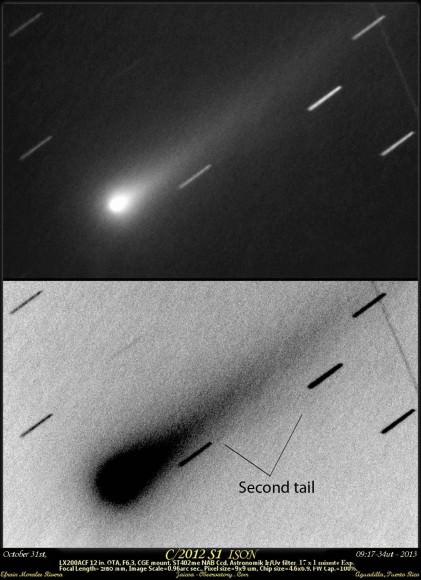

Ion tails are composed of gases like carbon monoxide and carbon dioxide blown into a narrow straight tail by the solar wind and electrified to fluorescence by the sun’s ultraviolet light. Being made of ions (charged particles), they interact with the sun’s wind of charged particles. Changes in the intensity and direction of the magnetic field associated with sun’s exhalations kink and twist ion tails into strange shapes. Strong particle blasts can even snap off an ion tail. Not that a comet could care. Like a lizard, it grows a new one back a day or three later.
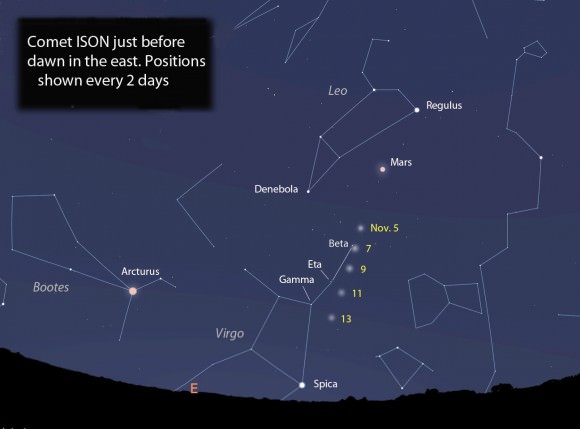
A fresh forked tail isn’t ISON’s only new adornment. Its inner coma, location of the bright “false nucleus”, is becoming more compact, and the overall magnitude of the comet has been slowly but steadily rising. Two mornings ago I pointed a pair of 10×50 binoculars ISON’s way and was surprised to see it glowing at magnitude 8.5. Things happen quickly now that the comet is picking up speed While it appeared as little more than a small smudge, any comet crossing into binocular territory is cause for excitement. Other observers are reporting magnitudes as bright as 8.0. Estimates may vary among observers, but the trend is up. Seiichi Yoshida’s excellent Weekly Information about Bright Comets site predicts another half magnitude brightening over the next few days. You can use the map here to spot it in your own glass before the moon returns to the morning sky.

But wait, there’s more. Emmanuel Jehin, a member of the TRAPPIST ( TRAnsiting Planets and PlanetesImals in Small Telescopes) team, a group of astronomers dedicated to the detection of exoplanets and the study of comets and other small solar system bodies, reports a rapid rise in ISON’s gas production rate in the past several days. They’ve increased by a factor of two since Nov. 3. Could the spike be connected to the development of an ion tail? Jehin and team have also recorded two active jets coming from the comet’s nucleus using specialized filters. Dust production rates however have remained flat.

Casey Lisse of the Comet ISON Observing campaign (CIOC) reports that the Chandra X-ray Observatory just became the 9th spacecraft to image the comet . More details and photos should be available soon. The campaign predicts the comet will peak in brightness between -3 to -5 magnitude when it zips closest to the sun on Nov. 28. Want to ride alongside the comet during its passage through the inner solar system? Click on this awesome, interactive simulator.
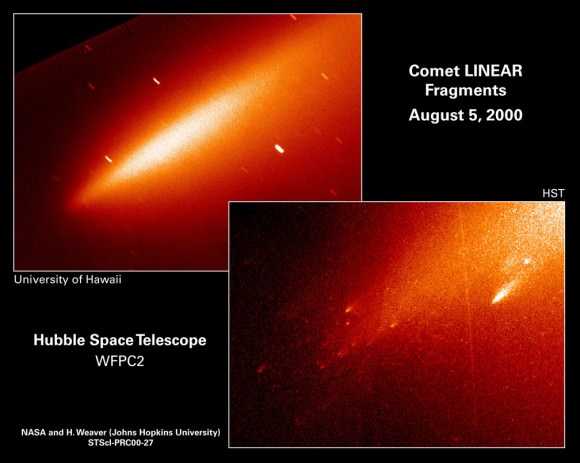
Hubble Space Telescope image of comet C/1999 S4 (LINEAR) that disintegrated around July 23, 2000. Credit: NASA/ESA
Because ISON is a fresh-faced visitor from the distant Oort Cloud that will soon face the full fury of the sun, speculation of its fate has ranged across the spectrum. Everything from breakup and dissolution before perihelion to surviving intact trailing a spectacular dust tail. The comet is currently approaching the 0.8 A.U. mark (74.4 million miles / 120 million km) when previous comets C/1999 S4 LINEAR in 2000 and C/2010 X1 Elenin in 2011 crumbled to pieces and vaporized away. Will ISON have the internal strength to pass the test and venture further into the solar boil? Should it survive, it faces a formidable foe – the sun. Both the intense solar heat and gravitational stress on the comet’s nucleus could easily tear it apart. If this happens a few days before perihelion we’ll be left with little to see, but if ISON busts up a day or two after perihelion, watch out baby. When the comet reappears in the morning sky, it may be missing its head but make it up for the loss with a spectacular tail of fresh dust and ice many degrees in length. This is exactly what happened to Comet C/2011 W3 (Lovejoy) in December 2011. After its close graze with the home star, the nucleus disintegrated, producing a striking tail seen by skywatchers in the southern hemisphere.
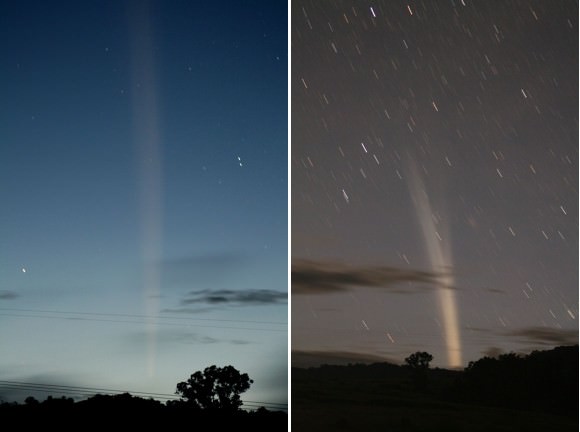
The final scenario sees Comet ISON pushing past all barriers intact and ready to put on a splendid show. Whatever happens, I suspect we’re in for surprises ahead. For a more detailed analysis of these possibilities I invite you check out Matthew Knight’s blog on the CIOC website.

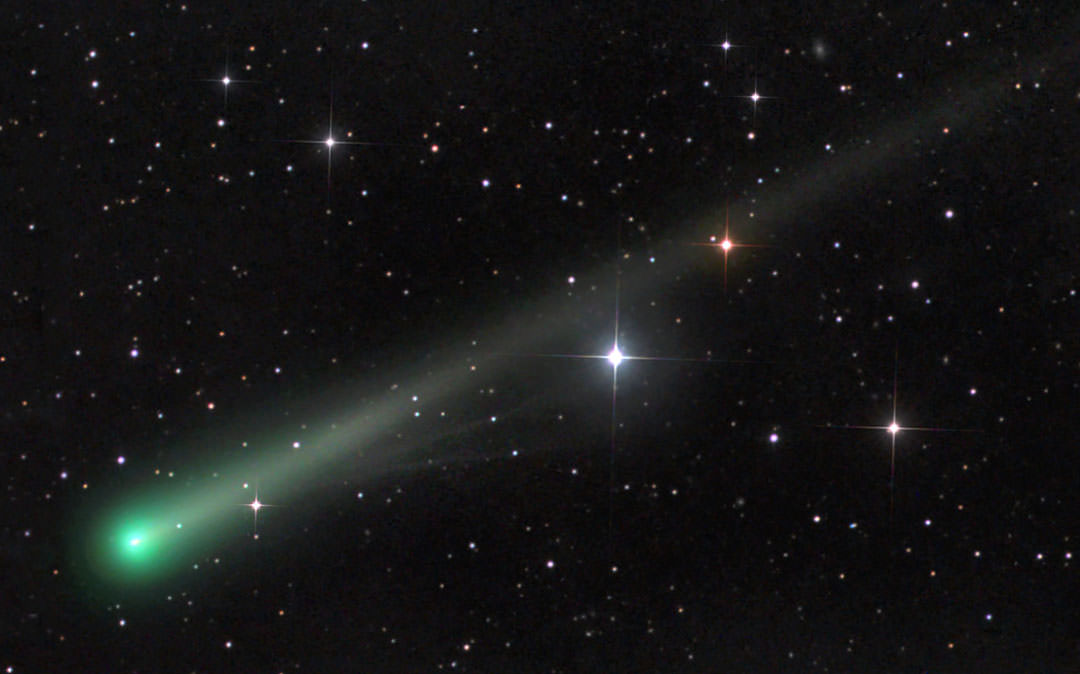
A point of pedantry if I may…
“Just before Dawn” – where???
Where the sun rises. . .
Here’s our detailed viewing guide of how and where to see Comet ISON up until its closest approach to the Sun on Nov. 28: http://www.universetoday.com/104818/
Gio,
If you check the map in the article you’ll see that the comet is in Virgo in the east-southeast sky about 1/2-2 hours before the start of dawn.
I live in northern Arizona, and this morning the sky was clear and transparent. at 430 am we got out the big binoculars, a pair of Ziess 11 x 80s to try to find the comet.
It was there all right, extremely faint oval shaped with no trace of tail in the binos. We were not able to find it for certain with the 9 x 63 binoculars. I think t his is because the head is very small and starlike still, and there is not a trace of tail visually to key you on where to scan.
Ill post some photos on my web site this week. stay tuned.
Chris Schur
Hi Chris
I live in DC and I got up this morning at 5 AM and tried to spot it. Can you please help me realise if I’m doing the right thing? I was looking right of Orion constellation to find the comet. I found a few smudges but I’m not sure which one is Ison. can you please help ?
Clear skies
Ron.
Ron,
Just consult the map included in the article and it will help you find ISON. Right now it’s far to the east and south of Orion. Good luck!
Glad to read you here also, Astro Bob…
Thank you Seven Star Hand!
Here’s a question…
Is it Paragraph 6? Where it says “The comet is currently approaching the 0.8 A.U. mark (744 million miles / 1.2 billion km)”
My recollection is that 1 A.U is about 150,000,000 km, so wouldn’t 0.8 AU be more like 120,000,000 km/75,000,000 miles? The conversions provided would be more like 8 AU. A missed decimal place perhaps?
Yea, you’re right. Someone made a typo on their calculator and didn’t bother to fact check… Or they misread the scientific notation.
Hi Sean,
Just a brain fart (decimal place). Thanks for pointing it out. It’s corrected now.
If it’s now visible in the morning sky, won’t it be visible in the evening sky after perihelion?
What could be the reason that the dust production is off compared to other comets? Was the extra tail expected?
I can’t wait until she is here. Check out this video of her. http://www.youtube.com/watch?v=h48525mqDKQ
Nice! I saw ISON last weekend and was underimpressed so it’s great to hear it’s getting brighter! Weather gods permitting… I’ll be out there tomorrow morning! Prosit!
Any Chance we will ever get to see it from Australia?
The planet is spinning, during its spin which is daily, we all “the whole planet” point toward this comet every morning 1/2-2 hours before the start of dawn in the same place in the sky and time for everyone.
Thanks 🙂
I believe there is little ice (actual frozen water) in this comet.
Instead, I believe Jim McCanney who says there will be a large electrical interaction with the sun… and other near objects. So we’ll see.
it’s nice to believe in things when you have no proof of them. very religious of you.
very troll of YOU
not at all, i’m not the one trolling here.
Hey I’m just quoting McCanney. So (as I said) we’ll see.
What if you receive your proof, Doug?
Might open your mind – but we must all still wait for it to play out.
Quite religious of you to believe NASA btw, heheh…
there have been many comets that have come very near the sun. there has been no evidence of electrical interaction. why should ISON be any different?
Nice UI on this page about Ison:
http://www.cometison2013.co.uk/perihelion-and-distance/
Depends on relative positions between the Earth and the comet.
I tried to spot Lovejoy this AM but I was shivering too hard to hold the binocs steady.. and apparently I was looking in the wrong place too. =/ I hate winter..
Cold builds character. 😉
Great read I’m really looking forward to this event . Thanks .
Fellow Astronomers…..
The Chicago Astronomer crew had the opportunity to observe and image two comets in our early morning skies recently. Both comets ISON and Lovejoy were documented and imaged by myself and C.A. members on a cold and gusty session. Comets Linear & Encke were not visible to us at this time, but we tried.
Details and full pics here:
http://astronomer.proboards.com/index.cgi?action=display&board=Observations&thread=4537&page=1
ISON, the “Dud of the Century” would put Kohutek to shame, but the winner here is Comet Lovejoy…which is riding high and at magnitude +6, a decent photographic target….and no body talking about. Superior to ISON for now, but still not a naked-eye object. Visible in my 15×70 binoculars, a nice fuzz patch was enjoyed in the C11…but no tail.
No plans are made at this time for public viewings of these visitors, but let’s see how these comets fair after perihelion and on their way back out. We can do a public session or two. They may flare up…or do nothing.
Stay tuned.
Astro Joe